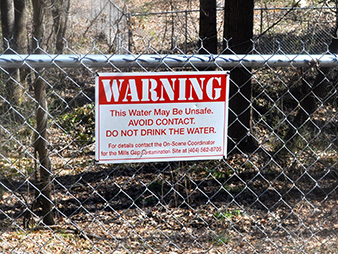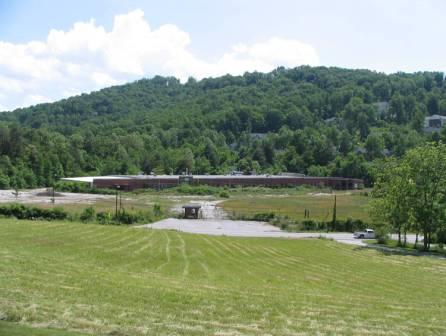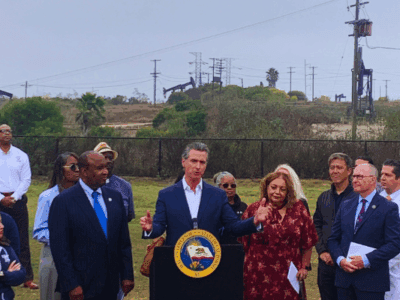Statutes of Limitations, Statutes of Repose, and Latent Harms
Can plaintiffs harmed years after exposure to toxic substances seek relief?

You may not have heard of CTS Corp. v. Waldburger. At a glance, it is relatively unremarkable, a private nuisance suit between landowners and a retired manufacturing facility. Much of the work on the plaintiffs’ side has been handled by students. In a sense, the case hasn’t even begun yet—a judge found that the plaintiffs waited to long to sue.
But the case is getting noticed. After a successful appeal by the plaintiffs, and another appeal by the defendants, the U.S. Supreme Court has agreed to take the case. Since then, some big players have weighed in on both sides, with amicus curiae (“friend of the court”) briefs coming from the Solicitor General, a large defense attorneys’ organization, and industry groups including the American Chemistry Council in support of the petitioner, and the Natural Resources Defense Council,* a group of retired Marines, and several prominent environmental law professors in support of the respondents (see hyperlinks to briefs). Why the attention?
(*Disclosure: the UCLA Environmental Law Clinic represented NRDC, and I worked on the brief.)
First, the basics of the case. In 2009, an Asheville, North Carolina, family learned that their well contained toxic substances—TCE and PCE, common industrial solvents linked to cancer. The family lived near a shuttered facility that had previously used these solvents in connection with manufacturing and electroplating operations. Together with neighbors, the family brought a nuisance action against CTS Corporation, the former operator of the facility, alleging property damage and possible health problems. A federal judge dismissed the case, finding that the plaintiffs were barred by North Carolina statute, which says that for cases of personal injury or property damage, “no cause of action shall accrue more than 10 years from the last act or omission of the defendant giving rise to the cause of action.” CTS had sold the facility more than 20 years earlier, in 1987.

With assistance from the Wake Forest University Appellate Advocacy Clinic, the plaintiffs appealed this decision, arguing that the North Carolina statute was preempted by Section 309 of the Comprehensive Environmental Response, Compensation, and Liability Act (CERCLA, AKA the “Superfund law”). Section 309 preempts state time limitations on claims for personal injury and property damage caused by hazardous waste contamination, by delaying the start of the limitations periods until a plaintiff knew (or reasonably should have known) that they had suffered injury as a result of such contamination. The law was enacted in the wake of new understanding about latent environmental harms, brought to the nation’s attention in the 1970s and 1980s as a result of high-profile contamination discoveries, including the infamous Love Canal disaster. The idea behind Section 309 was that plaintiffs harmed by hazardous waste should not be barred from seeking recovery before they even knew that they were injured. Unlike most traditional tort injuries, harms caused by toxic contamination—including cancer and other latent illnesses, as well as concealed property damage in the form of soil and groundwater contamination—may not be discovered for years after contamination first enters the environment (this issue was the primary focus of NRDC’s amicus brief).
The Fourth Circuit Court of Appeals agreed with the landowners, holding that they could proceed with their case. CTS appealed this decision to the U.S. Supreme Court, which granted cert in January. CTS argues that Section 309 does not apply to the North Carolina statute, because the North Carolina law was a “statute of repose” rather than a statute of limitations. As articulated by CTS, statutes of repose are defined by reference to the defendant’s actions (commonly, the last act or omission of a defendant), while a statute of limitations begins relative to actions of the plaintiff (such as the date that the plaintiff is injured or discovers her injury). CTS argues that a statute of limitations is therefore a “procedural” bar to recovery, designed to encourage plaintiffs to bring cases in a timely manner, while a statute of repose is a “substantive” bar, which defines the limits of a plaintiff’s rights regardless of the plaintiff’s diligence in discovering harm or bringing suit, and regardless even of the plaintiff’s knowledge of being harmed. According to CTS, Section 309 applies only to the former; it preempts state limitations periods “specified in the State statute of limitations or under common law,” but omits any reference to “repose.” The plaintiff neighbors say statutes of repose are statutes of limitation—a subset of the larger class—and that Section 309 applies to state limitations periods regardless of how they are formulated or presented.
This case therefore focuses heavily on the difference between a statute of limitations and a statute of repose. The answer is a little foggy. Historically, these have been indistinguishable or interchangeable: the fifth edition of Black’s Law Dictionary (from 1979), says that “[s]tatutes of limitation are statutes of repose,” and notes that statutes of limitation are also sometimes referred to as “statutes of repose.” Today, statutes of repose have been distinguished from statutes of limitation along the lines argued by CTS (that is, statutes of repose begin running on a date that the defendant acts or could have acted, rather than on the date of the plaintiff’s harm or knowledge of harm). However, statutes often establish repose periods within what would be considered—and is often termed explicitly—a statute of limitations. In common parlance, someone—a sophisticated lawyer, even—might refer to a statutory time limit on suit as a “statute of limitations,” even if it technically established a repose period. Of course, the issue in Waldburger isn’t just the difference between these classes of limitations periods—it’s whether Congress meant to distinguish the two terms so as to apply Section 309 to the one but not the other. Congress enacted Section 309 in 1986.
The rules of preemption are also potentially at issue in this case. It’s clear that Congress intended to preempt state law in some circumstances, but the parties have argued over how this intent should be weighed as to statutes of repose. On the one hand, preemption is disfavored whenever Congress does not clearly exhibit an intention to preempt. On the other, “remedial” statutes like CERCLA are generally read broadly in a way that favors preemption of less-protective state laws. Of course, if statutes of repose are (or at least in 1986 were) statutes of limitation, Section 309 would clearly preempt North Carolina’s law.
Other issues are at the fringes. How should we weigh the rights of plaintiffs to recover for latent harms against the right of defendants to become free from liability—eventually—for things that they did years in the past? How can and should tort law be applied to concealed or dormant injuries? Given the long delays that sometimes accompany environmental harms, these questions can be important, even outside the context of CERCLA contamination.
To date, courts have been inconsistent in applying Section 309 to statutes of repose (see here and here). This probably explains the Court’s interest. But what’s in it for everyone else?
In short, it’s what happens next. The outcome of Waldburger will affect not only the parties involved, but many other plaintiffs, especially in the near future. In what has been called “worst and largest drinking water contamination in U.S. history,” U.S. Marines and family members exposed to contaminated soil and groundwater at Camp Lejeune in North Carolina are presently involved in litigation against the U.S. government. Because the Marines’ case also involves decades-old contamination occurring in North Carolina, their claims may be subject to the same repose period at issue in Waldburger. The Camp Lejeune litigation is the reason for most of the amici involvement. Several Marines exposed at this site have detailed their injuries in an amicus brief filed in Waldburger. Likewise, the Solicitor General’s brief makes it plain that the government has gotten involved in Waldburger in order to avoid tort liability at Camp Lejeune (see also coverage in USA Today). NRDC’s brief addresses latent contamination injuries generally, including those to the military service members and families who have lived and worked on the thousands of military waste sites that have yet to be cleaned up.
Though Waldburger may have less obvious or sweeping impact than some other more prominent cases (UARG v. EPA, anyone?), it is likely to impact some people significantly, and it may affect how courts look at latent environmental harms. You can follow the case on SCOTUSblog. Argument is scheduled for April 23.







Reader Comments